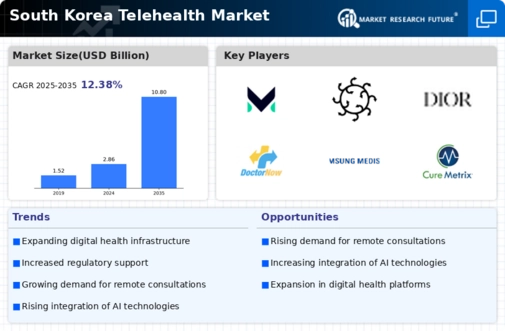Changing Consumer Preferences
Consumer preferences in South Korea are shifting towards more convenient healthcare solutions, significantly impacting the telehealth market. Patients increasingly favor remote consultations over traditional in-person visits, valuing the flexibility and time savings associated with telehealth services. Recent surveys indicate that approximately 70% of South Koreans express a preference for virtual consultations, particularly for non-emergency medical issues. This shift is likely to drive demand for telehealth services, as patients seek to avoid long wait times and travel inconveniences. Additionally, the growing awareness of mental health issues has led to an increase in teletherapy services, further expanding the market. As consumer preferences continue to evolve, the telehealth market is poised for substantial growth in the coming years.
Increased Focus on Preventive Care
There is a growing emphasis on preventive care within the South Korean healthcare system, which is positively influencing the telehealth market. Telehealth services facilitate early detection and management of health issues, promoting a proactive approach to healthcare. With the government and healthcare providers advocating for preventive measures, telehealth platforms are being utilized for routine check-ups, health education, and lifestyle management. This shift towards preventive care is expected to enhance patient engagement and adherence to treatment plans. As a result, the telehealth market is likely to see increased adoption of services that focus on preventive health, aligning with broader public health goals and improving overall health outcomes.
Aging Population and Chronic Diseases
The demographic landscape in South Korea is characterized by an aging population, which is a significant driver for the telehealth market. As the elderly population increases, so does the prevalence of chronic diseases such as diabetes and hypertension. It is estimated that by 2025, over 20% of the population will be aged 65 and above, necessitating more accessible healthcare solutions. Telehealth services offer a viable option for managing chronic conditions, allowing for regular monitoring and consultations without the need for frequent hospital visits. This trend not only enhances patient outcomes but also alleviates the burden on healthcare facilities. Consequently, the telehealth market is likely to expand as it addresses the unique needs of an aging demographic.
Technological Advancements in Healthcare
The telehealth market in South Korea is experiencing a surge due to rapid technological advancements. Innovations in mobile health applications, wearable devices, and artificial intelligence are enhancing patient care and accessibility. For instance, the integration of AI in diagnostic tools is streamlining processes, allowing healthcare providers to offer timely interventions. As of 2025, the market is projected to grow at a CAGR of approximately 15%, driven by these technological improvements. Furthermore, the proliferation of high-speed internet and smartphone penetration facilitates seamless communication between patients and healthcare professionals, thereby expanding the reach of telehealth services. This trend indicates a robust future for the telehealth market, as technology continues to evolve and integrate into everyday healthcare practices.
Cost-Effectiveness of Telehealth Solutions
The economic advantages of telehealth solutions are becoming increasingly apparent in South Korea, driving growth in the telehealth market. Telehealth services can reduce healthcare costs for both providers and patients by minimizing the need for physical infrastructure and travel expenses. Studies suggest that telehealth can lower overall healthcare costs by up to 30%, making it an attractive option for budget-conscious consumers and healthcare systems alike. Additionally, the ability to provide timely care through telehealth can prevent costly emergency interventions, further enhancing its cost-effectiveness. As healthcare costs continue to rise, the telehealth market is likely to benefit from this trend, as more stakeholders recognize the financial benefits of adopting telehealth solutions.

















Leave a Comment